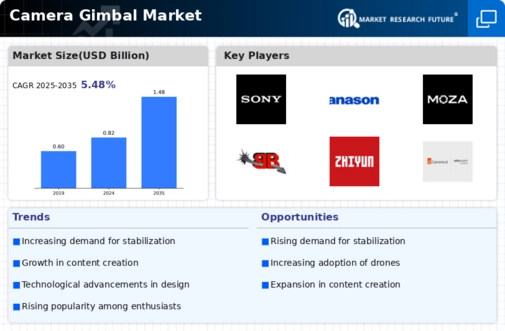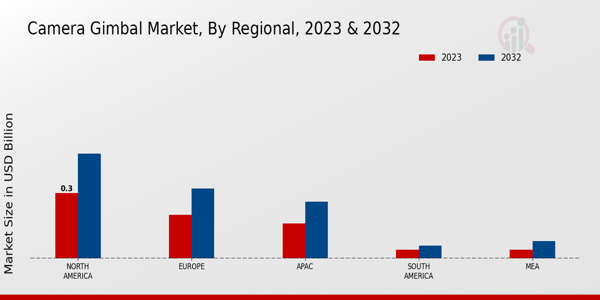Market Growth Projections
The Global Camera Gimbal Market Industry is poised for substantial growth, with projections indicating a market value of 0.82 USD Billion in 2024 and an anticipated increase to 1.48 USD Billion by 2035. This growth trajectory suggests a compound annual growth rate of 5.49% from 2025 to 2035, reflecting the industry's resilience and adaptability. Factors such as technological advancements, increasing demand for content creation, and the rise of drone usage contribute to this optimistic outlook. As the market evolves, stakeholders are likely to focus on innovation and customer satisfaction to capitalize on emerging opportunities.
Increasing Demand for Content Creation
The Global Camera Gimbal Market Industry experiences a surge in demand driven by the growing popularity of content creation across various platforms. As social media and video-sharing applications gain traction, individuals and businesses alike seek high-quality video production tools. This trend is evidenced by the projected market value of 0.82 USD Billion in 2024, indicating a robust interest in stabilizing equipment. Content creators, including influencers and filmmakers, increasingly rely on gimbals to enhance video quality, thereby influencing purchasing decisions. The demand for professional-grade equipment is likely to continue, as the industry anticipates a market value of 1.48 USD Billion by 2035.
Expansion of E-commerce and Online Retail
The expansion of e-commerce and online retail significantly impacts the Global Camera Gimbal Market Industry. As more consumers turn to online platforms for purchasing photography and videography equipment, gimbals gain visibility and accessibility. E-commerce platforms provide a convenient avenue for consumers to explore various gimbal options, fostering competition among manufacturers. This trend is likely to enhance consumer awareness and drive sales, contributing to the anticipated market growth. The increasing reliance on online shopping aligns with the projected compound annual growth rate of 5.49% from 2025 to 2035, indicating a positive outlook for the gimbal market.
Rise of Drone Photography and Videography
The rise of drone photography and videography significantly influences the Global Camera Gimbal Market Industry. Drones equipped with gimbals provide aerial perspectives that enhance the visual storytelling experience. As the demand for aerial footage increases in sectors like real estate, tourism, and cinematography, gimbals become essential for stabilizing camera movements. This trend is likely to drive market growth, as more consumers and professionals invest in gimbal technology to complement their drone setups. The synergy between drones and gimbals is expected to contribute to the overall market expansion, aligning with the projected market value of 1.48 USD Billion by 2035.
Growing Adoption in Professional Filmmaking
The Global Camera Gimbal Market Industry sees a growing adoption of gimbal technology in professional filmmaking. Filmmakers increasingly recognize the importance of stabilization equipment in producing high-quality cinematic experiences. Gimbals enable smooth camera movements that enhance storytelling, making them indispensable tools on film sets. As the film industry evolves, the demand for innovative filming techniques drives the need for advanced gimbal systems. This trend is likely to contribute to the market's growth trajectory, with a projected value of 0.82 USD Billion in 2024, reflecting the industry's commitment to delivering exceptional visual content.
Technological Advancements in Gimbal Design
Technological innovations play a pivotal role in shaping the Global Camera Gimbal Market Industry. Recent advancements in stabilization technology, such as improved motors and sensors, enhance the performance and usability of gimbals. These innovations allow for smoother footage and greater ease of use, appealing to both amateur and professional users. The integration of features like smartphone compatibility and wireless control further broadens the market's appeal. As these technologies evolve, they are expected to attract a wider audience, contributing to a compound annual growth rate of 5.49% from 2025 to 2035. This growth reflects the industry's commitment to meeting the diverse needs of content creators.















